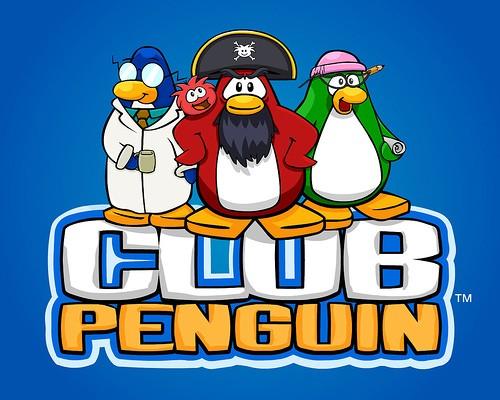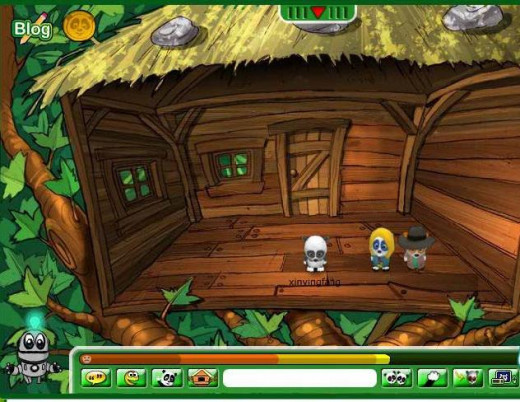Top Virtual World Games for Kids

Club Penguin
With more than 90 million users, Club Penguin is probably the most popular online multiplayer game EVER. There’s something deeply satisfying about controlling a tiny penguin across the screen. The rooms/places you can visit in the game are visually appealing, and the happy music adds to the whole experience. Players can adopt little pets called “puffles” and take care of them, visit parties, make friends and complete missions.
Wii and DS games, an official YouTube channel, toys and books have been created based on Club Penguin, so kids can be involved without the need of a computer too.
In fact, Club Penguin is so popular, people have created fan sites for the game, where they blog about things like mini-games, glitches and cheats. YouTube channels have been made where players of Club Penguin make “episodes” of the online game.
However, there is a disadvantage to all this. It’s extremely addicting. Good luck getting your child off the computer!

Habbo Hotel
Habbo Hotel is for over 13s, so its audience isn’t as young as Club Penguin’s. There have been quarrels on the news about Habbo and how due to the little to none chat filter, pedophiles could pose as young kids and “type” bad things to them. However, this happens on every site for older kids, and it's encouraged that the child ignores or reports suspicious behavior. Their chat has also become safer, disallowing the use of bad language.
Habbo is a sort of pixelated virtual world that takes place in a hotel with many rooms (many, MANY rooms). Users have their own “home room” they can decorate, but they can also create new rooms in the hotel for other people to visit.
One really good thing about Habbo Hotel is that even if you don’t have a membership, you can buy things (using pixels and credits), decorate your home, and participate in events. This is something that is lacking from most games. The slogan is “a hangout for teens” which definitely stands.

Toontown
Toontown is colorful, 3D and a simply amazing game to play. It’s a wonderful world that you step into, where robots called “cogs” are causing distraught all over town, and you, along with other players, must defeat them using funny actions such as throwing pies in their faces.
Players create a “toon” in various shapes, sizes, colors and animals. There are missions and tasks, and you can also design your own home and own pets (called “doodles”). When I played this, I would simply walk all over town and gaze at the sheer beauty and color of the game (may I remind you that this was years ago and the graphics are probably not up to standard now). The currency is “jellybeans”, something which never fails to make me smile. Ah, the innocence of childhood.

Moshi Monsters
Moshi Monsters has exploded in popularity with young kids (65 million users!). Kids can choose from a “monster” and customize it, name it and nurture it. They can navigate around “Monstro City”, playing puzzles and making friends. They can personalize their room and buy things with the currency “Rox”.
Much like Club Penguin, Moshi Monsters has extended out into the physical world, with toys, magazines, a DS game, books, lunch boxes, music albums and even pasta! This is a brilliant colorful game that kids will surely enjoy!

Poptropica
Poptropica is a game made by Jeff Kinney, the very author of the Diary of a Wimpy Kid books! Now if that doesn’t get the kids playing, I don’t know what will!
When you first join the game, you create a character. You can customize their hair, clothes and skin color. Character names are generated using nouns and adjectives. For example, Red Tree or Magic Sky. You can also make friends and complete quests together.
It’s a cartoonish game where you click on your surroundings to jump, move or roll towards them. There are currently 26 islands you can travel to, and are encouraged to complete a quest on. Completing a quest earns you a medallion and 100 credits that you can spend in the Poptropica Store (to buy things like clothes and abilities).
Most popular for kids between the ages of 8 to 15, this game is astonishingly addicting. However, some older people play it too since 35 million of the 75 million users are between the ages of 15 and 25.

Planet Cazmo
This virtual world is set on an alien planet, where players use 3D avatars to move around (it’s a point and click game like Club Penguin).
In Planet Cazmo, you can design your character and house, play a large amount of games, complete quests, attend celebrity concerts, hang out with friends, visit countless places, earn coins and even meet pirates and fish for aliens!
Something which makes it different from other online virtual world games is that there is a jukebox, where you can listen to the latest hits while you’re playing the game.

Panfu
Panfu is a virtual world game for kids between the ages of 6 and 13. You can create your own panda, interact with other users, play games and complete quests on the island of Panfu. A useful feature is the learning games in the “underwater school” which helps kids learn things like mathematics and Spanish.
There’s something very happy and cheery about his game, and that would make sense since the name “Panfu” was generated from two words: “panda” (the characters) and the Chinese word for happiness, “fu”. The world is colorful and vibrant, set in beautiful locations to guide your character around in.
The music matches the scenery perfectly, which makes you feel like you’re actually in the game. There are tons of items you can interact with, which adds to the game’s experience. Panda levels are something kids can work on achieving, which makes Panfu feel like a much more interactive game than some.
Like every other game, you can pay for a membership, which in Panfu’s case is becoming a Gold Panda. There aren’t as many players as other games (only about 15 million registered users), but this game has been compared to Club Penguin and is absolutely brilliant.
So, what game is best?
All of the games listed are interesting games kids can invest their time in. Many of them have been translated into different languages, which can help the child learn a new one.
I have split these games into a table, where you can see what features each one has.









